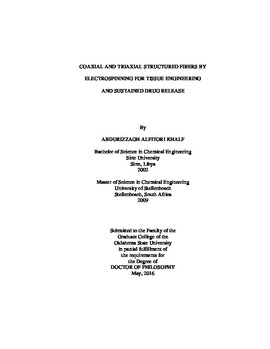| dc.contributor.advisor | Madihally, Sundararajan V. | |
| dc.contributor.author | Khalf, Abdurizzagh Alfitori | |
| dc.date.accessioned | 2017-02-22T22:09:45Z | |
| dc.date.available | 2017-02-22T22:09:45Z | |
| dc.date.issued | 2016-05 | |
| dc.identifier.uri | https://hdl.handle.net/11244/48825 | |
| dc.description.abstract | Coaxial and triaxial electrospinning are novel methods for fabrication of multilayered nano and micro-size fibers with desirable features such as co-solution blending, reinforced core, porous and hollow structure. However, the effect of type of fluids, solvent volatilities, polymer molecular weight, and co-solution blending properties (hydrophobicity/hydrophilicity) in multi-layered fibers have not been studied. In this work, coaxial electrospinning process was explored to determine the effect of type of core and solution rheology on jet stability and fibers formation using cellulose acetate (CA) as the shell material. Results from coaxial electrospinning of CA suggested that the fibers could be formed when the viscosity of the core is less than that of the sheath. Gelatin, chitosan, and mineral oil could be used as core fluids in the formation of core-shell and hollow CA fiber. Next, the coaxial process was scaled up to triaxial electrospinning to evaluate the effect of solvent volatility, type of polymer, polymer molecular weight, polymer solubility and polymer-solvent interactions at the interface and the mechanism of encapsulating the core fluid in multiaxial electrospinning. In triaxial electrospinning successful fiber formation was dependent on ensuring that the outer shell formed first, i.e., the relative solvent volatility of encapsulating core polymer to be lower than that of the shell polymer solvent. Based on the fundamental understanding of the formation of multiaxial fibers, I explored the use of these systems in a drug delivery application using biocompatible polymers of PCL blended gelatin (GT). In particular, I investigated the influence of hydrophobicity, hydrophilicity, drug-loading location, fiber size and co-solution blending properties in regulating the drug release in multi-layered fibers using Doxycycline (Dox) as a hydrophilic drug model. Drug release at 37 degrees C over 5 days was controlled in coaxial GT-core and PCL/GT-core fibers while PCL-core had the least performance. The presence of additional layers decreased the burst release and tenability of drug release based on the selection of appropriate core-polymer. Thus, the unique fabrication process can be used to tailor the mechanical properties, biological properties and release of various factors, which can be potentially useful in a number of applications. | |
| dc.format | application/pdf | |
| dc.language | en_US | |
| dc.rights | Copyright is held by the author who has granted the Oklahoma State University Library the non-exclusive right to share this material in its institutional repository. Contact Digital Library Services at lib-dls@okstate.edu or 405-744-9161 for the permission policy on the use, reproduction or distribution of this material. | |
| dc.title | Coaxial and triaxial structured fibers by electrospinning for tissue engineering and sustained drug release | |
| dc.contributor.committeeMember | Rhinehart, R. Russell | |
| dc.contributor.committeeMember | Johannes, A. J. | |
| dc.contributor.committeeMember | Vaidyanathan, Ranji | |
| osu.filename | Khalf_okstate_0664D_14677.pdf | |
| osu.accesstype | Open Access | |
| dc.type.genre | Dissertation | |
| dc.type.material | Text | |
| thesis.degree.discipline | Chemical Engineering | |
| thesis.degree.grantor | Oklahoma State University | |
